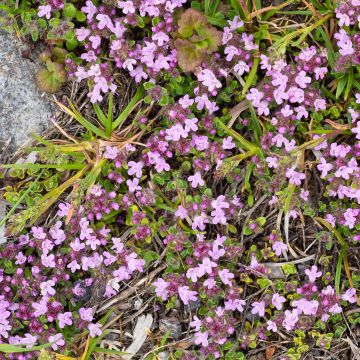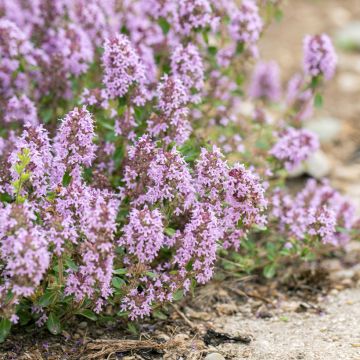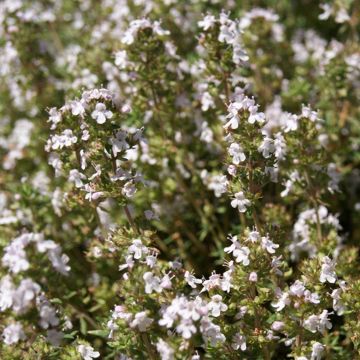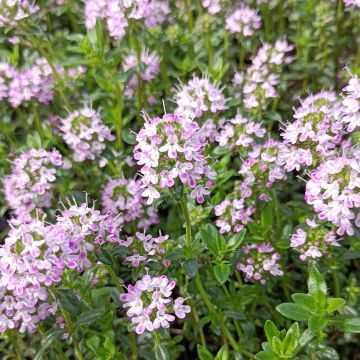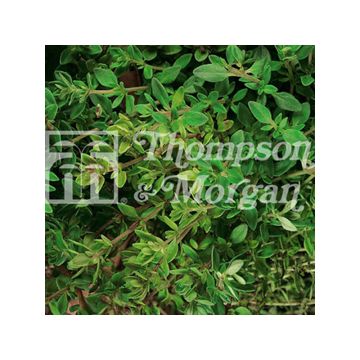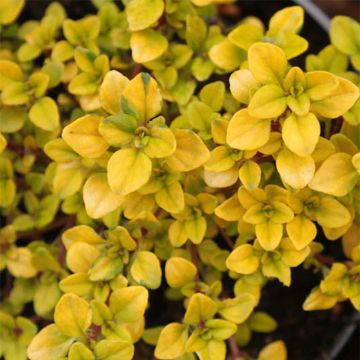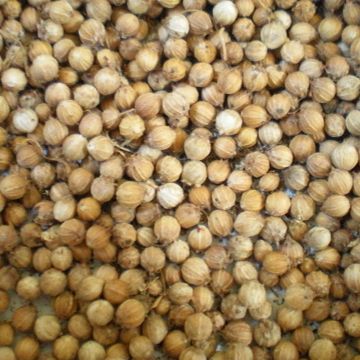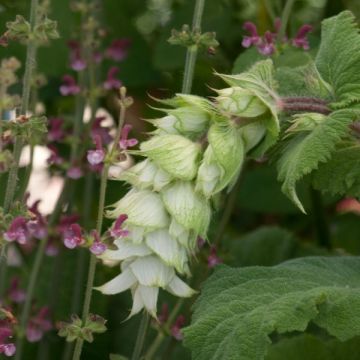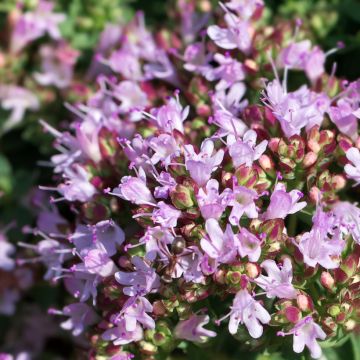

Thymus pulegioides Splendens
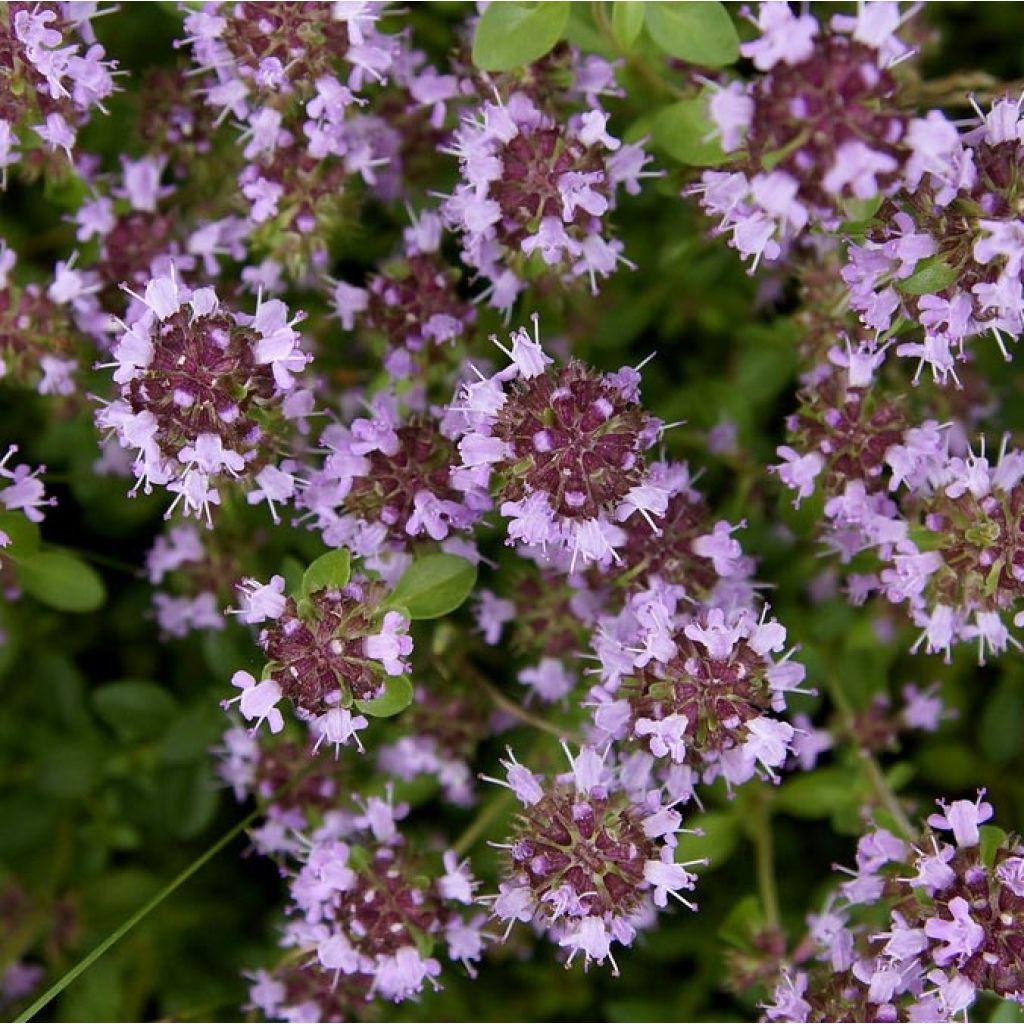

Thymus pulegioides Splendens
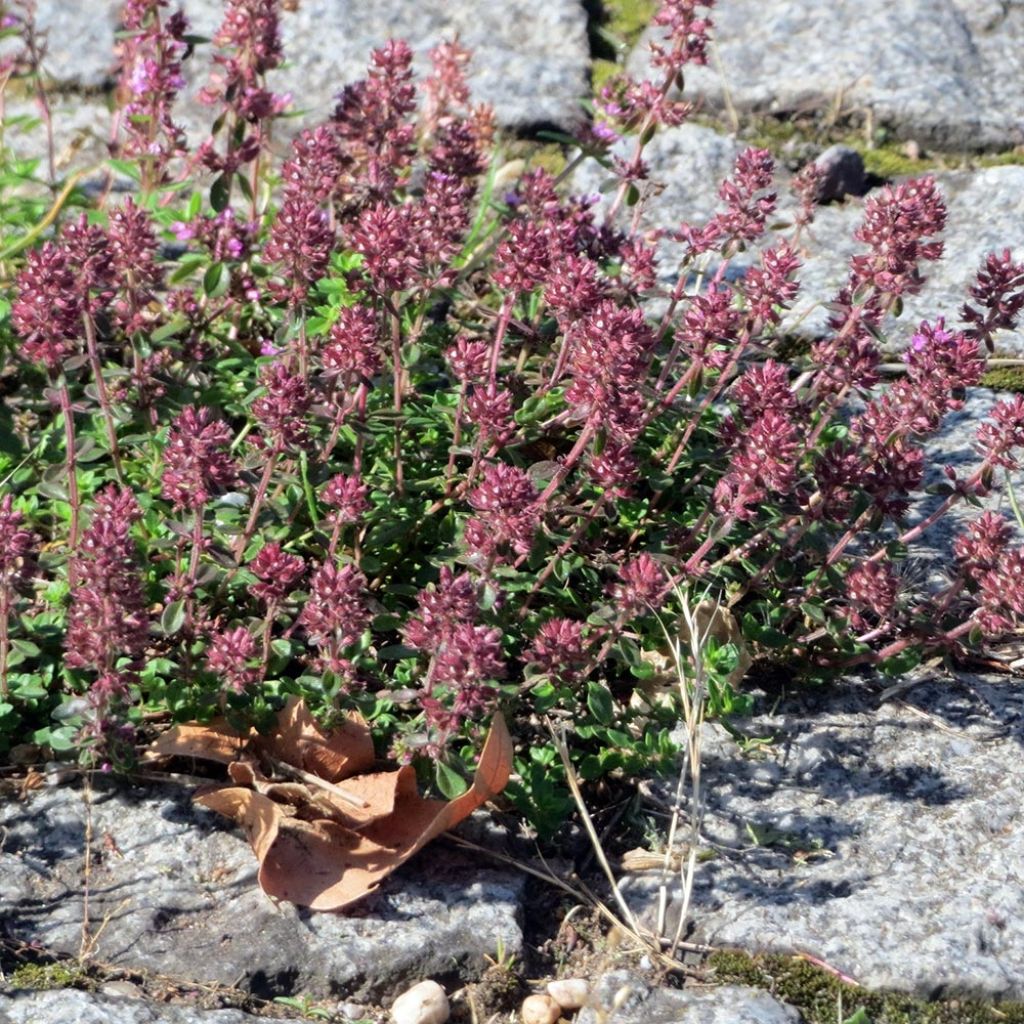

Thymus pulegioides Splendens
Thymus pulegioides Splendens
Thymus pulegioides Splendens
Why not try an alternative variety in stock?
View all →This plant carries a 6 months recovery warranty
More information
We guarantee the quality of our plants for a full growing cycle, and will replace at our expense any plant that fails to recover under normal climatic and planting conditions.
From €5.90 for pickup delivery and €6.90 for home delivery
Express home delivery from €8.90.
Description
Le Thym faux pouillot parfois confondu avec le serpolet, Thymus pulegioides ‘Splendens’ est une variété formant des touffes non rampantes dont les feuilles dégagent un parfum plus prononcé que le Thym serpolet qui contrairement à ce dernier apprécie le calcaire. Ses feuilles aromatisent de nombreux plats et son parfum convient particulièrement aux viandes et légumes. Cette variété constitue également un excellent couvre-sol de 10à 20 cmde hauteur. Le Thym se plaît dans la plupart des types de sols, y compris caillouteux mais craint les excès d'humidité. Plantez-le au printemps ou à l'automne et récoltez toute l'année.
Originaire d’Europe occidentale et du sud, où il se rencontre parfois à l’état naturel, le Thym est un sous-arbrisseau vivace qui appartient à la famille des Lamiacées. Rustique, il forme des petites touffes odorantes au feuillage vert grisé persistant. Cette plante mellifère offre de jolies petites fleurs en été dont la couleur varie de blanc au rose-mauve selon les variétés. L’espèce pulegioides se distingue du serpolet (thymus serpyllum) par des feuilles plus larges et parfumées, presque sans poils et des fleurs en épis verticillés allongés au lieu de ronds.
Ses feuilles au parfum de garrigue sont très appréciées en cuisine. Utilisées seules ou en bouquet garni, associées avec du Laurier, du Persil et du Romarin, les feuilles de Thym aromatisent les plats mijotés, sauces, marinades et court-bouillons. Elles s'utilisent également en infusion, réputée pour soulager les maux digestifs.
Le Thym est une aromatique résistante et facile à cultiver, qui affectionne les sols pauvres, légers voire caillouteux et bien drainés. Si votre terre est plutôt humide et argileuse, nous vous conseillons plutôt de le cultiver en pot où il se plaira très bien.
Récolte : Le Thym peut être récolté tout au long de l’année car ses feuilles sont persistantes. Cueillez de préférence le matin. Le Thym est le plus parfumé au moment de la floraison, en été. Sachant qu’il convient de le tailler pour lui conserver une belle forme compacte, profitez-en pour en faire provision pour les mois d’hiver !
Conservation : Le Thym se conserve traditionnellement par séchage. Après avoir lavé et séché les tiges, suspendez les bouquets, têtes en bas, dans un endroit sec et aéré. C’est une opération simple et rapide que vous pouvez remplacer par la congélation si cela vous apparaît plus pratique.
Le petit truc du jardinier : Au jardin, n’hésitez pas à mélanger les genres en installant quelques aromatiques comme le Thym au beau milieu de vos massifs de vivaces ou encore dans les rocailles. Elles s'y intégreront à merveille et les parfums parfois puissants des plantes aromatiques ont souvent la faculté d’éloigner les insectes susceptibles d’attaquer les végétaux un peu sensibles comme certains rosiers.
Report an error about the product description
Thymus pulegioides Splendens in pictures




Harvest
Plant habit
Foliage
Other Thyme
Planting and care
Le Thym est une aromatique résistante et facile à cultiver, qui affectionne les sols pauvres, légers voire caillouteux et bien drainés. Si votre terre est plutôt humide et argileuse, nous vous conseillons plutôt de le cultiver en pot où il se plaira très bien. La plantation s'effectue au printemps (en avril-mai) ou à l'automne (septembre – octobre).
En pleine terre : Choisissez une exposition très ensoleillée. Espacez les plants de 20 cm en tous sens. Creusez un trou (3 fois le volume de la motte), apportez du compost bien mûr, placez la motte et recouvrez de terre. Tassez et arrosez légèrement.
En pot : installez au fond du pot un lit de graviers ou de billes d'argile pour faciliter le drainage. Remplissez le pot avec un mélange de terreau et de terre de jardin. Placez la motte, recouvrez de terre et tassez bien. Arrosez légèrement. Placez votre pot au soleil.
Côté entretien, procédez à un arrosage très modéré, essentiellement en été, car le Thym n'apprécie pas les excès d'humidité. Pour la culture en pot, ne laissez pas d'eau stagner dans la soucoupe.
Une taille annuelle (sur le bois de l’année) lui conservera un joli port arrondi et trapu.
Le thym se multiplie par division de touffes ou par bouturage, en été. Cette opération est recommandée au bout de quelques années, notamment sous un climat froid et humide.
Cultivation
Care
Intended location
This item has not been reviewed yet - be the first to leave a review about it.
Herbs
Haven't found what you were looking for?
Hardiness is the lowest winter temperature a plant can endure without suffering serious damage or even dying. However, hardiness is affected by location (a sheltered area, such as a patio), protection (winter cover) and soil type (hardiness is improved by well-drained soil).

Photo Sharing Terms & Conditions
In order to encourage gardeners to interact and share their experiences, Promesse de fleurs offers various media enabling content to be uploaded onto its Site - in particular via the ‘Photo sharing’ module.
The User agrees to refrain from:
- Posting any content that is illegal, prejudicial, insulting, racist, inciteful to hatred, revisionist, contrary to public decency, that infringes on privacy or on the privacy rights of third parties, in particular the publicity rights of persons and goods, intellectual property rights, or the right to privacy.
- Submitting content on behalf of a third party;
- Impersonate the identity of a third party and/or publish any personal information about a third party;
In general, the User undertakes to refrain from any unethical behaviour.
All Content (in particular text, comments, files, images, photos, videos, creative works, etc.), which may be subject to property or intellectual property rights, image or other private rights, shall remain the property of the User, subject to the limited rights granted by the terms of the licence granted by Promesse de fleurs as stated below. Users are at liberty to publish or not to publish such Content on the Site, notably via the ‘Photo Sharing’ facility, and accept that this Content shall be made public and freely accessible, notably on the Internet.
Users further acknowledge, undertake to have ,and guarantee that they hold all necessary rights and permissions to publish such material on the Site, in particular with regard to the legislation in force pertaining to any privacy, property, intellectual property, image, or contractual rights, or rights of any other nature. By publishing such Content on the Site, Users acknowledge accepting full liability as publishers of the Content within the meaning of the law, and grant Promesse de fleurs, free of charge, an inclusive, worldwide licence for the said Content for the entire duration of its publication, including all reproduction, representation, up/downloading, displaying, performing, transmission, and storage rights.
Users also grant permission for their name to be linked to the Content and accept that this link may not always be made available.
By engaging in posting material, Users consent to their Content becoming automatically accessible on the Internet, in particular on other sites and/or blogs and/or web pages of the Promesse de fleurs site, including in particular social pages and the Promesse de fleurs catalogue.
Users may secure the removal of entrusted content free of charge by issuing a simple request via our contact form.
The flowering period indicated on our website applies to countries and regions located in USDA zone 8 (France, the United Kingdom, Ireland, the Netherlands, etc.)
It will vary according to where you live:
- In zones 9 to 10 (Italy, Spain, Greece, etc.), flowering will occur about 2 to 4 weeks earlier.
- In zones 6 to 7 (Germany, Poland, Slovenia, and lower mountainous regions), flowering will be delayed by 2 to 3 weeks.
- In zone 5 (Central Europe, Scandinavia), blooming will be delayed by 3 to 5 weeks.
In temperate climates, pruning of spring-flowering shrubs (forsythia, spireas, etc.) should be done just after flowering.
Pruning of summer-flowering shrubs (Indian Lilac, Perovskia, etc.) can be done in winter or spring.
In cold regions as well as with frost-sensitive plants, avoid pruning too early when severe frosts may still occur.
The planting period indicated on our website applies to countries and regions located in USDA zone 8 (France, United Kingdom, Ireland, Netherlands).
It will vary according to where you live:
- In Mediterranean zones (Marseille, Madrid, Milan, etc.), autumn and winter are the best planting periods.
- In continental zones (Strasbourg, Munich, Vienna, etc.), delay planting by 2 to 3 weeks in spring and bring it forward by 2 to 4 weeks in autumn.
- In mountainous regions (the Alps, Pyrenees, Carpathians, etc.), it is best to plant in late spring (May-June) or late summer (August-September).
The harvesting period indicated on our website applies to countries and regions in USDA zone 8 (France, England, Ireland, the Netherlands).
In colder areas (Scandinavia, Poland, Austria...) fruit and vegetable harvests are likely to be delayed by 3-4 weeks.
In warmer areas (Italy, Spain, Greece, etc.), harvesting will probably take place earlier, depending on weather conditions.
The sowing periods indicated on our website apply to countries and regions within USDA Zone 8 (France, UK, Ireland, Netherlands).
In colder areas (Scandinavia, Poland, Austria...), delay any outdoor sowing by 3-4 weeks, or sow under glass.
In warmer climes (Italy, Spain, Greece, etc.), bring outdoor sowing forward by a few weeks.


































